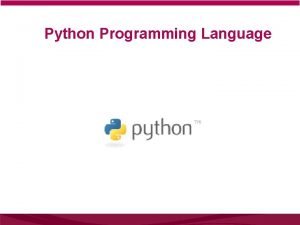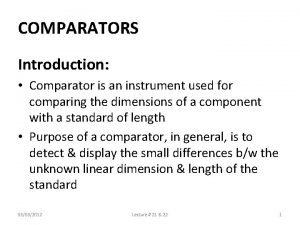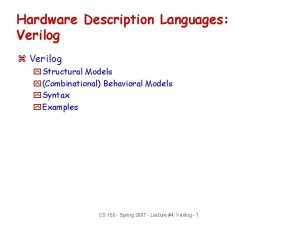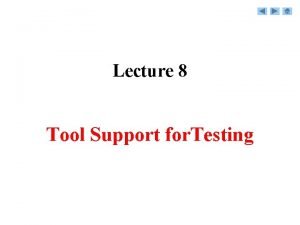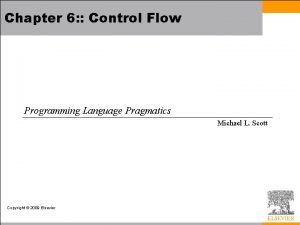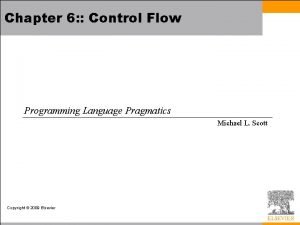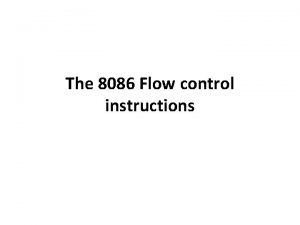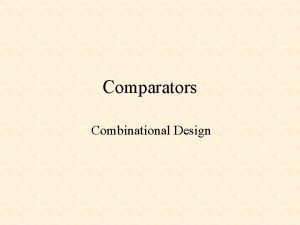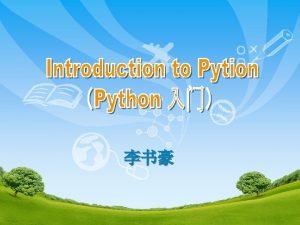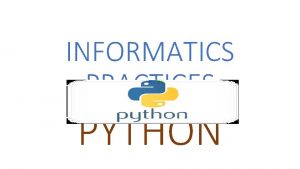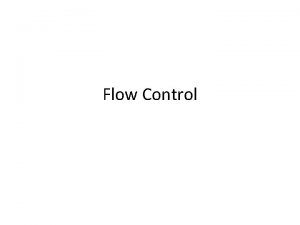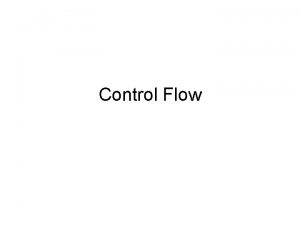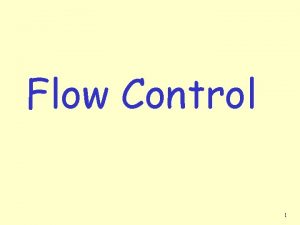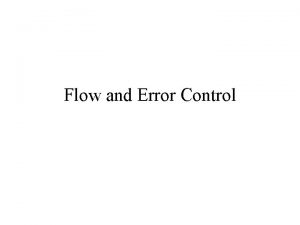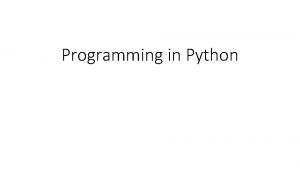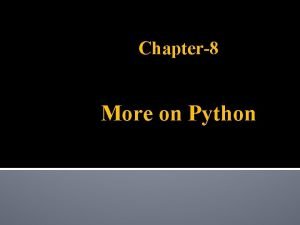Python Programming Language Control Flow Comparators There are













- Slides: 13

Python Programming Language

Control Flow - Comparators There are 6 Comparators: • Equal to (==) • Not equal to (!=) • Less than (<) • Less than or equal to (<=) • Greater than (>) • Greater than or equal to (>= Note that == is used to compare whether two things are equal, and = is used to assign a value to a variable

Control Flow - Comparators • bool_one = True • bool_two = True • bool_three = False • bool_four = False • bool_five = False

Boolean operators. and, or, not • • • Boolean operators (or logical operators) are words used to connect Python statements in a grammatically correct way—almost exactly as in regular English. There are three boolean operators in Python: and, which means the same as it does in English; or, which means "one or the other or BOTH" (it's not exclusively one or the other); not, which means the same as it does in English. Boolean operators result in Boolean values— True or False.

The AND boolean operator • • • The boolean operator AND only results in True when the expressions on either side of AND are both true. An expression is any statement involving one or more variables and operators (arithmetic, logical, or boolean). For instance: 1 < 2 and 2 < 3 results in True because it is true that one is less than two and that two is less than three. 1 < 2 and 2 > 3 results in False because it is not true that both statements are true—one is less than two, but two is not greater than three.

The OR boolean operator • • • The boolean operator OR only returns True when either (meaning one, the other or both!) of the expressions on each side of OR are true. (It's only False when both expressions are False. ) For example: 1 < 2 or 2 > 3 is True, even though two is not greater than three; 1 > 2 or 2 > 3 is False, because it is neither the case that one is greater than two nor that two is greater than three.

The NOT boolean operator • • The boolean operator NOT returns True for false statements and False for true statements. Remember, the only two boolean values are True and False! For example: not False will evaluate to True, as will not 40 > 41. Applying not to expressions that would otherwise be true makes them False

This and That (or This, But Not That!) • • Boolean operators can be chained together! It's important to know that boolean operators are not evaluated straight across from left to right all the time; just like with arithmetic operators, where / and * are evaluated before + and - There is an order of precedence or order of operations for boolean operators. The order is as follows: – not is evaluated first; – and is evaluated next; – or is evaluated last. This order can be changed by including parentheses (()). Anything in parentheses is evaluated as its own unit.

Conditional Statement Syntax • • • Remember whitespace in Python is significant? In Java. Script, the block of code an ifstatement executes is bound by curly braces ({}). In Python, whitespace (tabs or spaces) does this work for us. Here's an example of if statement syntax in Python: if 8 < 9: print "Eight is less than nine!" if is always followed by an expression, which is followed by a colon (: ). The code block (the code to be executed if the expression evaluates to True) is indented four spaces. This is also true for elif and else(which we'll get to in a moment). The full syntax would look something like this: if 8 < 9: print "I get printed!" elif 8 > 9: print "I don't get printed. " else: print "I also don't get printed”

Else conditional statement • • • The else statement in Python is the complement to the if statement. While an if statement will return control of the program to the next line of code after the if code block even if there's no else statement, it's considered a good habit to pair each if with an else. An if/else pair says to Python: "If this expression is true, run this indented code block; otherwise, run this code after the else statement. " else is always written alone. Unlike if, else should have nothing after it except a colon.

Elif conditional statement • "Elif" is short for "else if. " It means exactly what it sounds like: "otherwise, if the following code is true, do this!"

Here's what you've learned in this unit: • • Basics of control flow; Comparators (such as >, <, and==); Boolean operators (and, or, and not); And conditional statements (if, else, and elif).

And finally • • • def teachers_question(): print "You've just spent some time learning Conditionals and Control Flow in Python" print "Did you enjoy it and learn a lot? " answer = raw_input("Type Yes or No and hit 'Enter'. "). lower() if answer == "yes" or answer == "y": print "Brilliant, I'm glad you enjoyed it" elif answer == "no" or answer == "n": print "I'm sorry to hear that. Perhaps you'll need to start again and have another go!" else: print "You didn't pick Yes or No! Try again. " teachers_question() • •
 Mikael ferm
Mikael ferm Python comparators
Python comparators Function of mechanical comparator
Function of mechanical comparator If verilog
If verilog Tool support for testing
Tool support for testing Flow programming
Flow programming Flow programming language
Flow programming language Data flow vs control flow
Data flow vs control flow Control flow and data flow computers
Control flow and data flow computers Transaction flow graph
Transaction flow graph Stock control e flow control
Stock control e flow control Flow control and error control
Flow control and error control What is hardware description language
What is hardware description language Jz instruction in 8086
Jz instruction in 8086

